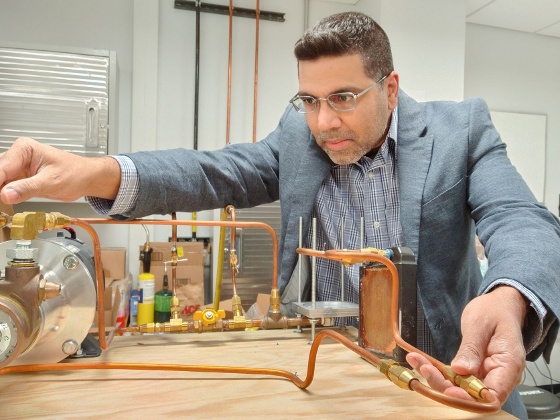 |
| June 21, 2022 | Volume 18 Issue 23 |
Designfax weekly eMagazine
Archives
Partners
Manufacturing Center
Product Spotlight
Modern Applications News
Metalworking Ideas For
Today's Job Shops
Tooling and Production
Strategies for large
metalworking plants
Cooling systems for laser weapons being tested by Air Force Research Lab and New Mexico State University

Using a laser diode system on loan from the Air Force Research Lab, New Mexico State University associate professor Dr. Krishna Kota tests the seal integrity of the cooling flow loop located in the Surface-environment Interaction Research Laboratory (SIRE Lab) at NMSU. The flow loop will be used to test the ability of novel two-phase cooling approaches in handling the highly challenging, transient heat densities of directed energy weapon systems. [Credit: Courtesy photo AFRL]
By Jeanne Dailey, U.S. Air Force Research Laboratory
The Air Force Research Laboratory, or AFRL, Directed Energy Directorate recently signed a five-year Strategic Education Partnership Agreement (EPA) with New Mexico State University (NMSU) in Las Cruces that extends the loan of a laser diode system NMSU will use in testing novel cooling solutions for directed energy laser and high-power microwave systems.
"Heat is one of the major bottlenecks for an efficient deployment of directed energy weapons, or DEWs," said Dr. Sean Ross, AFRL deputy high-energy laser technical area lead. "Heat generated during the operation of a DEW impacts power consumption and the overall size and weight of the system. AFRL is hoping NMSU's research will result in new and improved solutions for cooling those systems."
NMSU is ready to resume testing DEW cooling solutions after interruptions in 2020.
"Our researchers are excited to renew their research using AFRL's laser diode system as a heat source, after two years of being in lockdown because of COVID-19 restrictions," said Dr. Krishna Kota, NMSU associate professor. "The heat densities of DEWs are similar to those experienced at the exhaust of a rocket engine motor or in the close vicinity of a nuclear explosion. We have started to work again on a cooling flow loop that will be used to test the ability of a first-of-its-kind two-phase cooling approach in handling these highly challenging, transient heat densities. This cooling approach has already demonstrated record performance numbers in the preliminary experiments. If there are no unforeseen delays, we hope to complete the testing of the flow loop this year."
Ross said almost all current research into cooling laser diodes uses resistive heaters, like home space heaters, as a heat source for simulating heat from a DEW, though the heat load characteristics of an actual laser diode are very different from an electrical heater.
"AFRL's EPA with NMSU allows Dr. Kota's team to test their concepts on a real laser diode that turns on and off like an actual laser diode and not like a resistive heater," Ross said.
There are several benefits to NMSU in this strategic EPA, Kota explained.
"This EPA will allow our NMSU researchers to advance research in two-phase cooling for high heat flux applications," Kota said. "In addition, [it] gives us access to state-of-the-art equipment and research experience for graduate and undergraduate students, promoting the development of the STEM workforce in an area of national need. We look forward to providing AFRL with some useful results that will enhance their important work in directed energy for the nation's security."
"AFRL will benefit by seeing the thermal potential of two-phase cooling for laser diodes," Ross said.
Much previous research into surface enhancement for boiling has used very expensive and time-consuming vacuum deposition processes.
"NMSU's research in developing cooling solutions is about enhancing the boiling process with a technology that is inexpensive and can be done on any shape surface, so it's a big deal," Ross added.
Published June 2022
Rate this article
View our terms of use and privacy policy
